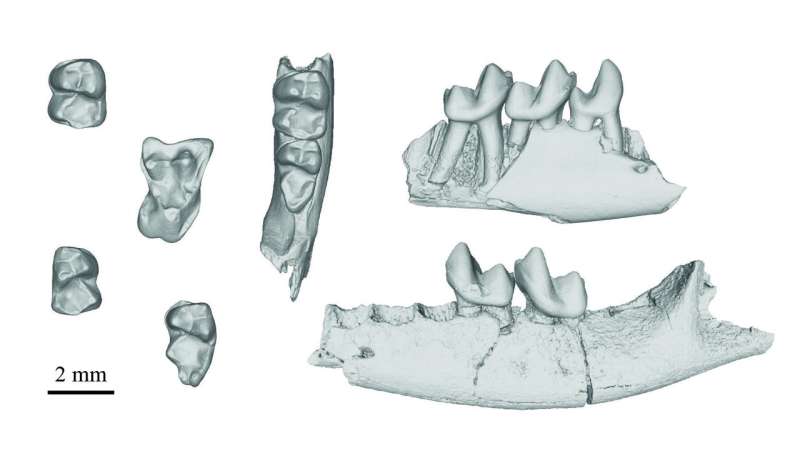https://phys.org/news/2021-02-fossil-discovery-illuminates-earliest-primates.html
Shortly after the extinction of the dinosaurs, the earliest known archaic primates, such as the newly described species Purgatorius mckeeveri shown in the foreground, quickly set themselves apart from their competition -- like the archaic ungulate mammal on the forest floor -- by specializing in an omnivorous diet including fruit found up in the trees.
Credit: Andrey Atuchin
Stephen Chester, an assistant professor of anthropology and paleontologist at the Graduate Center, CUNY and Brooklyn College, was part of a team of 10 researchers from across the United States who analyzed several fossils of Purgatorius, the oldest genus in a group of the earliest-known primates called plesiadapiforms. These ancient mammals were small-bodied and ate specialized diets of insects and fruits that varied across species.
This discovery is central to primate ancestry and adds to our understanding of how life on land recovered after the Cretaceous–Paleogene extinction event 66 million years ago that wiped out all dinosaurs, except for birds. This study was documented in a paper published in the journal Royal Society Open Science.
"This discovery is exciting because it represents the oldest dated occurrence of archaic primates in the fossil record," Chester said. "It adds to our understanding of how the earliest primates separated themselves from their competitors following the demise of the dinosaurs."
Chester and Gregory Wilson Mantilla, Burke Museum Curator of Vertebrate Paleontology and University of Washington biology professor, were co-leads on this study, where the team analyzed fossilized teeth found in the Hell Creek area of northeastern Montana. The fossils, now part of the collections at the University of California Museum of Paleontology, Berkeley, are estimated to be 65.9 million years old, about 105,000 to 139,000 years after the mass extinction event.
Based on the age of the fossils, the team estimates that the ancestor of all primates (the group including plesiadapiforms and today's primates such as lemurs, monkeys, and apes) likely emerged by the Late Cretaceous—and lived alongside large dinosaurs.

High resolution CT scans of an assortment of fossilized teeth and jaw bone
s of Purgatorius. Credit: Gregory Wilson Mantilla/Stephen Chester
"Stephen Chester's high-caliber impactful research in this area with Brooklyn College students has significantly contributed to our understanding of the environmental, biological, and social dependencies that ultimately led to the evolution of primates," said Peter Tolias, dean of the School of Natural and Behavioral Sciences.
This is not the first big find Chester has been involved with. While this latest discovery is unique in that it focused on one group of mammals—primates—in 2019, Chester, along with current collaborator Wilson Mantilla, was a key member of a groundbreaking discovery that revealed in striking detail how many life forms—including mammals, turtles, crocodiles, and plants—recovered after the asteroid impact that wiped out the dinosaurs. Chester, who specializes in the early evolutionary history of primates and other placental mammals, was also a co-author of that peer-reviewed scientific paper in Science magazine with Denver Museum of Nature & Science researchers.
In 2015, while at Brooklyn College, Chester was also the lead author on a paper published in the Proceedings of the National Academy of Sciences on this same genus of primate, Purgatorius. His co-authored paper described the ankle bones of Purgatorius, which is still the oldest fossil evidence that primates lived in the trees shortly after the extinction of the dinosaurs.
"Stephen Chester's high-caliber impactful research in this area with Brooklyn College students has significantly contributed to our understanding of the environmental, biological, and social dependencies that ultimately led to the evolution of primates," said Peter Tolias, dean of the School of Natural and Behavioral Sciences.
This is not the first big find Chester has been involved with. While this latest discovery is unique in that it focused on one group of mammals—primates—in 2019, Chester, along with current collaborator Wilson Mantilla, was a key member of a groundbreaking discovery that revealed in striking detail how many life forms—including mammals, turtles, crocodiles, and plants—recovered after the asteroid impact that wiped out the dinosaurs. Chester, who specializes in the early evolutionary history of primates and other placental mammals, was also a co-author of that peer-reviewed scientific paper in Science magazine with Denver Museum of Nature & Science researchers.
In 2015, while at Brooklyn College, Chester was also the lead author on a paper published in the Proceedings of the National Academy of Sciences on this same genus of primate, Purgatorius. His co-authored paper described the ankle bones of Purgatorius, which is still the oldest fossil evidence that primates lived in the trees shortly after the extinction of the dinosaurs.
Recommend this post and follow The Life of Earth
https://disqus.com/home/forum/lifeofearth/


No comments:
Post a Comment
Stick to the subject, NO religion, or Party politics